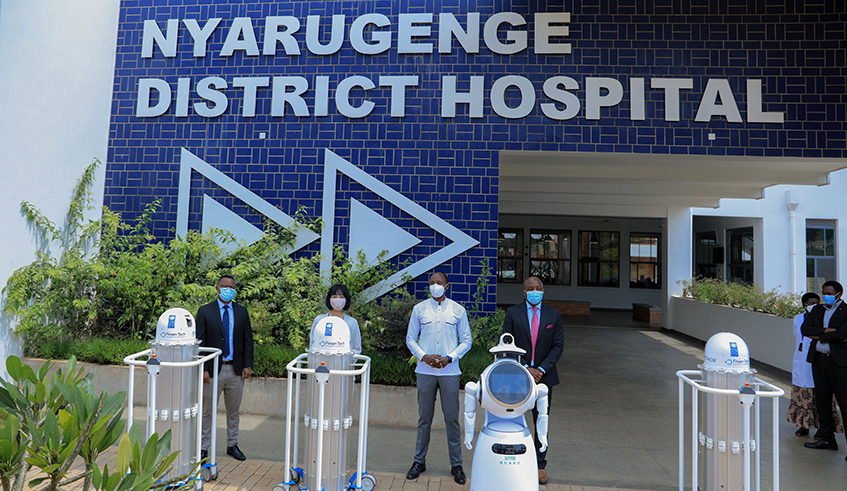

On Tuesday, February 9, Rwanda received Ultra Violet (UV-C) disinfectant robots, which, according to officials, will help in cleaning and disinfecting treatment centres, hospitals and places of mass gathering.
The robots, received at the recently launched Covid-19 treatment facility, were acquired through a partnership with the United Nations Development Programme (UNDP) as well as the Embassy of Japan in Rwanda.
The machines were manufactured by UK’s Finsen Tech Company
Here at the five things you should know about these robots.
Capacity to kill up to 99.9 per cent of harmful pathogens
The robots use ultraviolet germicidal irradiation (UV) to disinfect porous and non-porous surfaces without toxic chemicals.
According to Jules Kamugunga, an engineer at the Rwanda Biomedical Centre’s (RBC) Medical Technology Division, the automated, remote-controlled mobile disinfection system uses UV light that is capable to kill up to 99.9 per cent of harmful pathogens. A pathogen is simply a germ.
"The high energy from UV light is absorbed in the cellular RNA and DNA of microorganisms, damaging nucleic acids and preventing them from reproducing, in this case, they cannot survive or infect humans,” he said.
During the disinfection cycle, Kamugungu who is part of the 15 personnel trained to use the robots added, "Thor UVC robots don’t work if there is any obstacle. They measure the necessary amount of UVC energy that is reflected back to the robot to destroy pathogens throughout an entire room from one position. (Mainly from the center).”
Each robot cost Rwf68.9 million
Reliable information from the Ministry of ICT and Innovation indicate that each of the new robots cost $70,000 (Rwf68.9 million).
"They enable infection prevention control teams to do their work faster, smarter and even with precision. We have had more than 400 people on duty just for cleaning surfaces, and cleaning different places where the virus could have been present, but now these robots can actually do it very fast, very efficiently, and those people can do other work which is the whole purpose of having technology,” said Sabin Nsanzimana, Director General at RBC in an exclusive interview with The New Times.
Stationed in critical places
Two of the robots will be stationed at the Covid-19 treatment facility as well as the Kigali International Airport, respectively.
However, given that they are mobile, Nsanzimana said that the government will alter stations where necessary.
"We do not have enough…they are three robots and the good thing is that they are mobile and they can be deployed wherever they are needed.”
Second batch of robots
This is the second time the country is deploying robots to minimize contact between frontline workers and persons infected with the virus and to help enforce safety guidelines at strategic points.
In May last year, the government launched five high-tech robots that can perform a number of tasks related to Covid-19 management, including mass temperature screening, delivering food and medication to patients, capturing data, detecting people who are not wearing masks among others.
According to Yves Iradukunda, the Permanent Secretary at the Ministry of ICT and Innovation, during the fight against the pandemic, Rwanda has placed ICT at the centre of its transformation and health sector.
"I would like to extend our gratitude to the UNDP and the Government of Japan for their continued support towards our efforts and desire to leverage cutting-edge technologies in the fight against Covid-19. These robots offer a faster, more effective and less labor-intensive disinfection alternative to manual cleaning,” Iradukunda said during the launch on Tuesday.
One robot takes half an hour to disinfect a room
On average, according to Kamugunga, one THOR UVC robot can disinfect one room in less than 32 minutes. They can also kill viruses other than the SARS-CoV-2, the virus that kills Covid-19.


